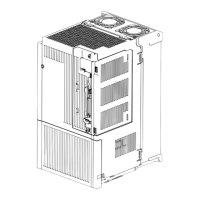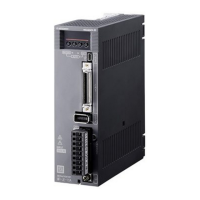What does memory error 2 mean on Mitsubishi MR-J4-70A Amplifier?
- TTonya McclureSep 5, 2025
Memory error 2 (EEP-ROM) on your Mitsubishi Amplifier can occur due to: * EEP-ROM error at power on. * EEP-ROM error during operation.

 Loading...
Loading...
What does memory error 2 mean on Mitsubishi MR-J4-70A Amplifier?
Memory error 2 (EEP-ROM) on your Mitsubishi Amplifier can occur due to: * EEP-ROM error at power on. * EEP-ROM error during operation.
Why does my Mitsubishi MR-J4-70A show an overvoltage error?
An overvoltage error in your Mitsubishi Amplifier is due to a main circuit voltage error.
What does encoder normal communication error 2 mean on Mitsubishi MR-J4-70A?
Encoder normal communication error 2 on your Mitsubishi Amplifier can be caused by: * Encoder data error 1. * Encoder data update error. * Encoder data waveform error. * Encoder non-signal error. * Encoder hardware error 1. * Encoder hardware error 2. * Encoder data error 2.
What causes a servo control error on my Mitsubishi MR-J4-70A Amplifier?
A servo control error on your Mitsubishi Amplifier (specifically for linear servo motors and direct drive motors) can be caused by: * Servo control error by position deviation. * Servo control error by speed deviation. * Servo control error by torque/thrust deviation. * Fully closed loop control error by position deviation. * Fully closed loop control error by speed deviation. * Fully closed loop control error by position deviation during command stop.
What does a board error on my Mitsubishi MR-J4-70A mean?
A board error on your Mitsubishi Amplifier indicates: * Board error 1. * Board error 2. * Board error 3.
What causes a regenerative error in my Mitsubishi MR-J4-70A Amplifier?
A regenerative error in your Mitsubishi Amplifier can stem from: * Regeneration heat error. * Regeneration signal error. * Regeneration feedback signal error.
What does parameter error mean on my Mitsubishi MR-J4-70A?
A parameter error on your Mitsubishi Amplifier indicates either a parameter setting range error or a parameter combination error.
What causes undervoltage on Mitsubishi MR-J4-70A?
Undervoltage in your Mitsubishi Amplifier can be due to: * Voltage drop in the control circuit power. * Voltage drop in the main circuit power.
Why is my Mitsubishi MR-J4-70A Amplifier showing a servo motor overheat error?
A servo motor overheat error in your Mitsubishi Amplifier can be due to: * Abnormal temperature of servo motor 1. * Abnormal temperature of servo motor 2. * Thermistor disconnected error. * Abnormal temperature of servo motor 3. * Abnormal temperature of servo motor 4.
What causes a main circuit error in my Mitsubishi MR-J4-70A?
A main circuit error in your Mitsubishi Amplifier can occur due to: * A ground fault detected by the hardware detection circuit. * A ground fault detected by the software detection function.
| Brand | Mitsubishi |
|---|---|
| Model | MR-J4-70A |
| Category | Amplifier |
| Language | English |
Details the power supply connections and precautions for safe operation, including magnetic contactors and circuit breakers.
Provides instructions and diagrams for proper grounding of the servo amplifier and servo motor.
Details the initial startup procedure, including wiring checks and parameter settings.
Provides specific startup procedures for the position control mode.
Provides specific startup procedures for the speed control mode.
Provides specific startup procedures for the torque control mode.
Lists all parameters, their symbols, initial values, units, and applicable modes.
Details the basic setting parameters like operation mode, regenerative option, and absolute position system.
Lists parameters related to gain adjustment, filters, and vibration suppression.
Lists parameters for configuring input and output signals, including function selections.
Details parameters specific to linear servo motors and DD motors, including magnetic pole detection.
Explains manual gain adjustment methods, including auto tuning modes and manual mode.
Details the gain adjustment modes available on a single servo amplifier.
Describes how to perform one-touch tuning using MR Configurator2 or push buttons.
Explains the real-time auto tuning function for estimating machine characteristics and setting optimum gains.
Details the available filters for MR-J4 servo amplifiers, including machine resonance and low-pass filters.
Explains the machine resonance suppression filter (notch filter) for suppressing mechanical resonance.
Describes the adaptive filter II function for automatically suppressing mechanical system vibration.
Explains advanced vibration suppression control for further suppressing load-side vibration.
Explains the function that allows equipment to continue operating even under alarm conditions.
Lists all possible alarms, their detail numbers, causes, and recommended actions for troubleshooting.
Lists all possible warnings, their detail numbers, and stop methods for troubleshooting.
Details the electronic thermal protection curves for servo motors and amplifiers under overload conditions.
Explains dynamic brake operation, including coasting distance calculation and time constants.
Describes brake unit combinations, parameter settings, and connection examples for safety applications.
Details the specifications and system configuration requirements for the MR Configurator2 software.
Recommends circuit breakers, fuses, and magnetic contactors for main and control circuit power supplies.
Provides methods for reducing noise from the servo amplifier and to peripheral devices.
Explains how to set parameters for enabling the absolute position detection system.
Details the battery types (MR-BAT6V1SET, MR-BAT6V1BJ) used for absolute position detection.
Outlines the steps for starting up the absolute position detection system, including battery installation and parameter setting.
Defines terms related to the STO function, such as uncontrolled stop and preventing unexpected start-up.
Provides essential safety notes for personnel involved in installation, start-up, and repair.
Outlines residual risks associated with the STO function and manufacturer responsibilities.
Provides the startup procedure for linear servo motors, including setting parameters and checks.
Details the magnetic pole detection procedures for linear servo motors using different methods.
Explains the requirements and operation of the absolute position detection system for linear servo motors.
Provides electronic thermal protection curves for linear servo motors under overload conditions.
Provides the startup procedure for direct drive servo systems, including magnetic pole detection.
Details the magnetic pole detection procedures for direct drive motors using MR Configurator2.
Describes the requirements and operation of the absolute position detection system for direct drive motors.
Provides electronic thermal protection curves for direct drive motors under overload conditions.
Explains how to select between semi closed loop, fully closed loop, and dual feedback control modes.
Details considerations for load-side encoders, including cable usage and compatibility.
Provides the startup procedure for the fully closed loop system.
Explains error detection functions for fully closed loop control, including speed and position deviation.
Describes requirements and restrictions for absolute position detection with linear encoders in fully closed loop systems.
Explains safety terms and the STO function's compliance with IEC/EN standards.
Provides general safety notes for users and operators before mounting or operating equipment.
Explains safety terms related to STO, SS1, and emergency operations for safety logic units.
Describes the STO function, its purpose, and compliance with safety standards.
Provides essential safety notes for personnel involved in installation and operation of safety logic units.
Outlines residual risks associated with STO/EMG functions and manufacturer responsibilities.
Provides troubleshooting steps for power supply issues and FAULT LED indications on the MR-J3-D05.











